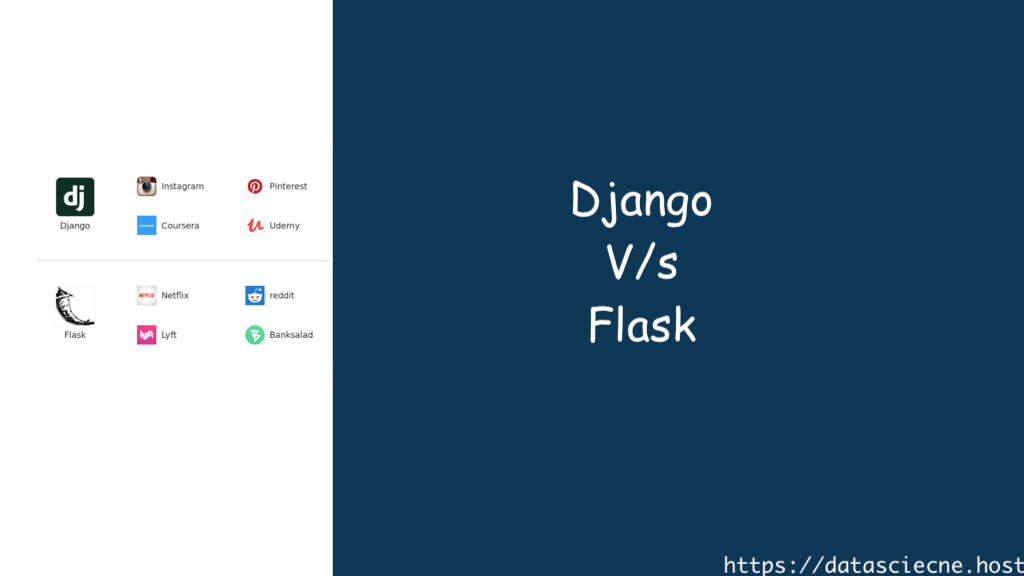Web frameworks are essential tools for building web applications, APIs, and deploying machine learning models. In the world of data science, these frameworks play a crucial role in creating user interfaces, serving predictions, and integrating data pipelines. Among the numerous options available, Django and Flask stand out as two popular Python web frameworks often considered by data scientists.
The purpose of this blog post is to provide a comprehensive comparison of Django and Flask, highlighting their strengths and weaknesses in the context of data science projects. By understanding the key differences between these frameworks, data scientists can make an informed decision on which one better aligns with their project requirements.
What is Django and Flask
Django
Django is a high-level, full-stack web framework that follows the “batteries-included” principle. It comes with a wealth of built-in features, making it a comprehensive solution for building complex web applications. For data science projects, Django offers several advantages:
- Admin Panel: Django’s admin interface allows you to manage and visualize data, which can be particularly useful for data exploration and monitoring.
- Security Features: Django prioritizes security with robust features like protection against cross-site scripting (XSS), SQL injection, and clickjacking.
- Object-Relational Mapping (ORM): Django’s ORM simplifies database interactions, making it easier to manage and query data.
Flask
In contrast, Flask is a lightweight, micro-framework that follows a minimalistic approach. It provides a solid foundation for building web applications but relies on third-party extensions for additional functionalities. Flask’s core strengths lie in its flexibility and simplicity:
- Flask’s minimalistic core allows for greater control over the project structure and dependencies.
- It uses extensions like Flask-SQLAlchemy for database integration and Flask-Login for authentication.
- Flask’s simplicity makes it easier to understand and integrate with other libraries or frameworks.
Key Differences for Data Science Projects
Development Approach
One of the main differences between Django and Flask lies in their development approach. Django follows an opinionated structure, which means it enforces specific conventions and project organization. This can be beneficial for larger teams and complex projects, as it promotes consistency and maintainability. Flask, on the other hand, takes a “build-your-own” approach, giving developers more flexibility in structuring their projects.
For data science projects that require rapid prototypotyping or integration with custom libraries, Flask’s flexibility can be advantageous. However, for larger-scale projects with multiple contributors, Django’s opinionated structure can help ensure code consistency and easier onboarding.
Built-in Features
Django comes with a wide range of built-in features, including an admin panel, ORM, and form handling. These features can greatly benefit data science projects by simplifying data management, visualization, and processing tasks. For instance, the admin panel can be used to explore and manipulate data, while the ORM can streamline interactions with databases.
Flask, being a microframework, relies on external extensions for similar functionalities. While this approach offers more control and customization, it also requires additional setup and integration efforts. Data scientists may need to spend time researching and combining various extensions to achieve the desired functionality.
Scalability and Security
Django is well-suited for building large-scale, complex applications that require scalability and robust security measures. Its comprehensive feature set and adherence to best practices make it easier to develop and maintain secure, high-performance applications. However, Django’s larger codebase and extensive dependencies can potentially introduce security vulnerabilities if not properly maintained.
Flask, with its minimalistic core, may have a smaller attack surface and be easier to secure. However, achieving scalability and robust security in Flask often requires integrating additional third-party libraries and implementing custom solutions, which can increase development time and complexity.
Choosing the Right Framework
To summarize the key differences between Django and Flask for data science projects, consider the following table:
| Feature | Django | Flask |
|---|---|---|
| Development Approach | Opinionated, convention-over-configuration | Flexible, “build-your-own” |
| Built-in Features | Extensive (admin panel, ORM, form handling) | Minimalistic core, relies on extensions |
| Scalability | Well-suited for large, complex applications | May require additional libraries/custom solutions |
| Security | Robust built-in security features | Smaller attack surface, but requires additional effort |
When choosing between Django and Flask for your data science project, consider factors such as project size, complexity, security requirements, and the team’s experience level. Django may be the better choice for larger projects with complex data management needs and a strong emphasis on scalability and security. Flask, on the other hand, can be advantageous for rapid prototypotyping, integration with custom libraries, or smaller projects where flexibility and simplicity are prioritized.
Additionally, there are other Python web frameworks worth considering, such as Pyramid, FastAPI, and Tornado, each with its own strengths and use cases.
Conclusion
Both Django and Flask are powerful and widely-used Python web frameworks that can greatly benefit data science projects. Django excels at providing a comprehensive set of built-in features, making it suitable for larger, complex projects that require robust data management and scalability. Flask, on the other hand, offers a lightweight and flexible approach, allowing for rapid prototypotyping and custom integrations.
Ultimately, the choice between Django and Flask depends on the specific requirements of your data science project, as well as the team’s experience and preferences. By carefully evaluating factors such as project complexity, scalability needs, and security requirements, you can make an informed decision and leverage the strengths of the chosen framework to streamline your data science workflows.
